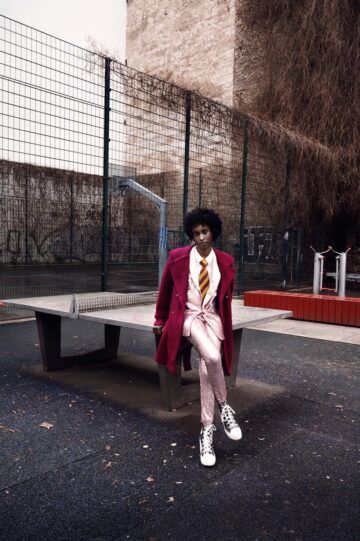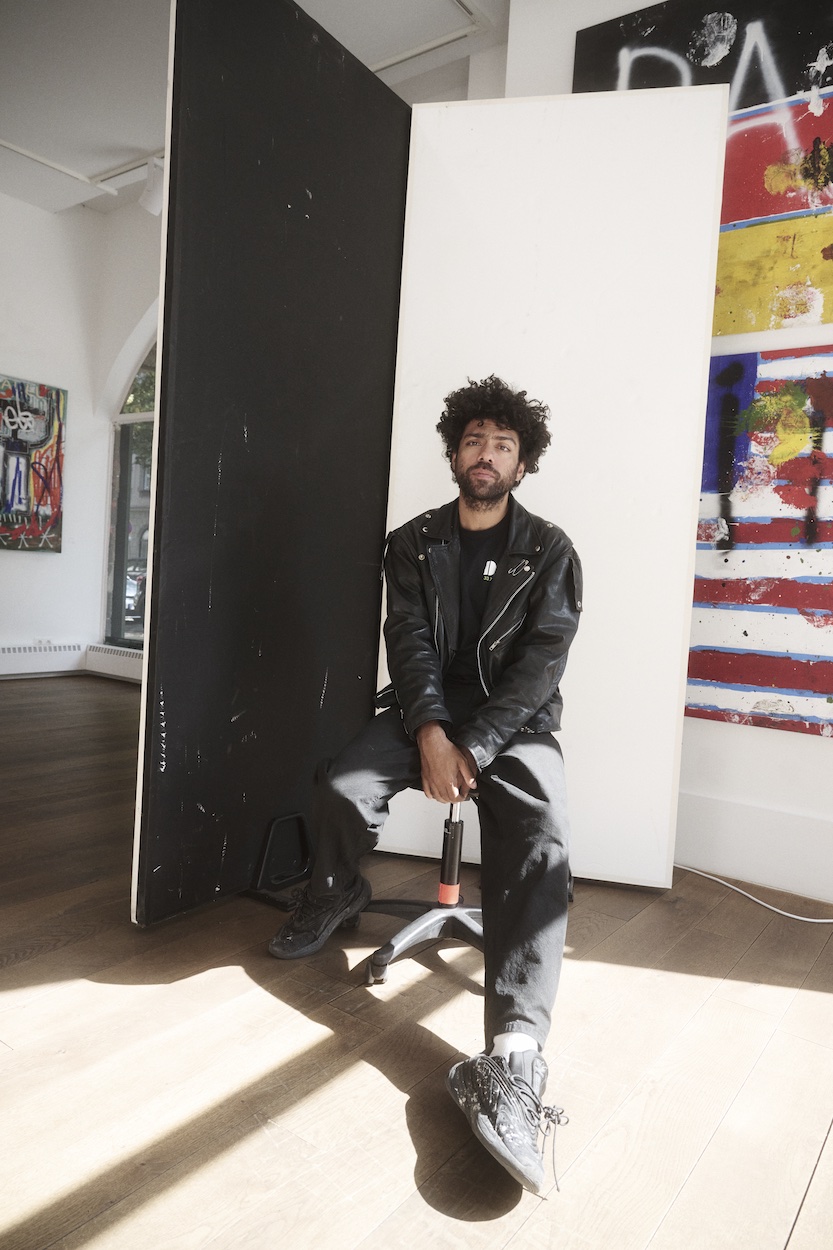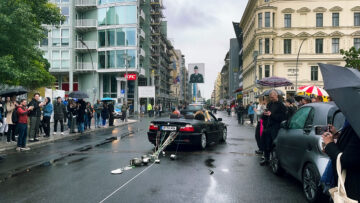
TRUE EQUALITY REQUIRES ONGOING EFFORTS: NUMÉRO BERLIN IN CONVERSATION WITH BRAZILIAN DESIGNER ALINE CELI
Aline Celi‘s path to design wasn't a sudden revelation. It was a lifelong fascination…
Interview by Sina Braetz









For Noah Becker, painting began as a way to calm his thoughts. Known as an artist, producer, and musician, he runs his own studio in Berlin – a hidden gem, especially for young people in the scene.
With his latest exhibition, Glass Half Full, Noah explores an optimistic perspective and the openness to embrace positive change. We spoke with Noah about this recent show, held at Galerie Mond in Berlin from July 27 to September 15, where he brought together his passions for music, sports, and art.
Well, that’s the daily struggle all the time. We have to continuously practice things and look at things with the glass half-full mentality, rather than looking at the negative consistently. And I was really happy to be so vulnerable on this show to explain how I practice that struggle on a daily basis. And practicing high-vibrational actions really puts things in perspective.
Yeah, well, that’s a piece called six feet beneath the ground, and I ran for 35 minutes on a tarp that I drew a basketball court on, so I think practicing repetitive motions in that way and not just praying but creating real, real moments where, for example, that piece of suicide is, I mean, that piece six feet beneath the ground is dedicated to friends who I’ve lost to suicide, and as an honor to them, I ran suicides on a piece of tarp where I’m thinking about them, praying with them, keeping them close to my heart, and paying respects to them while also doing heavy tasks to feel as connected as I can to them, you know, and to give respect to them as much as possible.
Well, for me, art can change the world.
It’s about exposing hypocrisy, like trying to break innocent 14, 15, or 16-year-olds while they’re just trying to play basketball, forcing them to run suicides. For me, it’s like, is the government trying to harm us? Or are they already planning to test who’s the toughest, creating division among the people instead of uniting us to say, “Yo, the people aren’t the problem, it’s the governments.”
We need to communicate with one another;
Well, I believe that structure is the yin to dreams. When someone has big dreams, sometimes they forget to structure those dreams and set realistic goals. It’s important to figure out how to delegate tasks to others, manage finances, and save money. The art itself is just as important as the ability to sustain it over a long period of time—the impact and longevity that your art has. So, for me, finding the balance between those two is very important, I believe.
I would consider myself a hoarder. My studio is full of different materials, tools, synthesizers, and various other things. I just collect a lot of stuff. For me, it’s always about having something for my family and my kids and being able to use all kinds of elements in my art while staying consistently engaged with different materials. I love mixing media. I really love mixing media.
I never use TikTok, but I do catch myself scrolling on Instagram. I also see both the positive and negative effects of TikTok, as well as the potential to use it for good. However, it’s clear how it can also have harmful effects and manipulate our society and people. That’s what the whole show is about, like the horseshoe theory—the yin and yang of everyday life.
You have to take the bad with the good and the good with the bad.
Honestly, probably, subconsciously, my whole life, those are probably my three greatest passions. I think I’ve always been very athletic, and now being able to use my athleticism and my God-given abilities within my painting, because I do believe sports is art as well; it’s all poetry in motion, you know, so I’m definitely inspired, just as I’m inspired by people like Alan Iverson and Kobe Bryant. I’m also inspired by people like Rebecca Hawn and Pope Al. So, yeah, to me, it’s all one rhythm, you know, same as I’m inspired by Jimi Hendrix and Lil Wayne. Those are all people that I have great respect for, so to me, it’s like people that are strong-minded, people that are strong-willed, people that see the beauty in the world, and that’s what I kind of wanted to show with this, that it’s like I take it on my shoulders, and I take it very seriously, and I take the impact I want to leave behind and the storytelling that I want to, the stories that I want to tell from the perspective that I have.
I truly believe that every day is a new opportunity for growth, so I can’t really pinpoint any specific moment because I approach each day as a fresh start and consistently practice letting go of all sorts of patterns. While I also believe that art can serve as a form of therapy, since I am also in therapy, it’s also about having empathy and considering others.
It’s all interconnected.
I often think of these things as a contrast between ego and eco, always striving to see each day as a new beginning.
I think everyone has trauma related to various societal systems, and people tend to have stronger opinions about certain issues than others. I truly believe that people should have the chance to be heard and to speak on matters, rather than being publicly shamed or blamed without a real solution in mind. I truly think what we are missing most in this moment is genuine dialogue, not through cellular devices. We face a lot of pressure from the rising costs in this consumeristic, capitalistic world. We really need to pay attention to detail and train like warriors, like athletes—be multifaceted and not lean too heavily in one direction. It’s important to do your own research and form your own conclusions.
Yeah, to be honest, that was a first for me as well, and I feel like it’s always a challenge to stay authentic in front of the camera while also losing yourself in the work. Thankfully, my cousin filmed the whole thing. He was wearing a mask because he was playing the role of the Internet, and the Internet has no face. I told him to put pressure on me and to get in the way of what I was trying to accomplish physically. We also held up cameras, and I really love making films. Like you said, being so vulnerable and in front of the camera helped me connect with myself on a deeper level. I stayed as present as possible and didn’t alter any piece of artwork or artifact that was created during that time. I stayed true to the moment.
It was really about trying something new and processing these thoughts that I had no way to fully let go of before. I’ve been working on this idea for almost two years. I love wordplay, movement, sound, and paying attention to what’s happening around me.
And, honestly, I truly love life.

Aline Celi‘s path to design wasn't a sudden revelation. It was a lifelong fascination…
Interview by Sina Braetz

With "Trade", K8 Hardy brought a performance to the streets of Berlin’s Checkpoint…

Photography by Brian Ziff